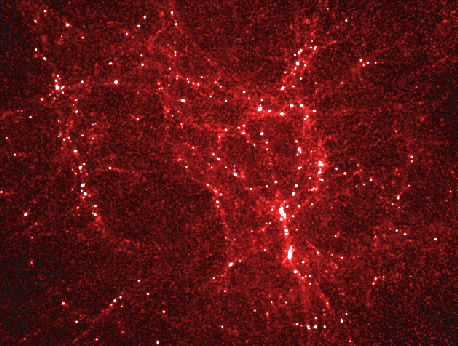Credit & Copyright: F. Summers (Princeton),
D. Cox, R. Patterson, E. Wesselak, and B. Sanders
(NCSA),
L. Carpenter
(Pixar),
GC3,
Cosmic Voyage,
Smithsonian
Explanation:
What did our
universe look like when it was young? To answer this, cosmologists run
sophisticated
computer programs tracking the locations of
millions of particles. The
above
animated frame is the result of such a
calculation and shows how our
universe
might have looked when it was just a fracton of its current
age.
The universe started out very smooth - matter
and light are spread almost uniformly. As time progressed,
gravity
caused slight gatherings of mass to accrete so that ever greater
conglomerations formed.
Galaxies and long
filaments
formed - which are shown by the bright patches and streaks in the
above
frame. An
IMAX movie including hundreds of these frames was nominated for
an academy award.
1999 2000 2001 2002 2003 2004 2005 2006 2007 2008 2009 2010 2011 2012 2013 2014 2015 2016 2017 2018 2019 2020 2021 2022 2023 2024 2025 |
Январь Февраль Март Апрель Май Июнь Июль Август Сентябрь Октябрь Ноябрь Декабрь |
NASA Web Site Statements, Warnings, and Disclaimers
NASA Official: Jay Norris. Specific rights apply.
A service of: LHEA at NASA / GSFC
& Michigan Tech. U.
|
Публикации с ключевыми словами:
early universe - Вселенная - галактики - волокна
Публикации со словами: early universe - Вселенная - галактики - волокна | |
См. также:
Все публикации на ту же тему >> | |
